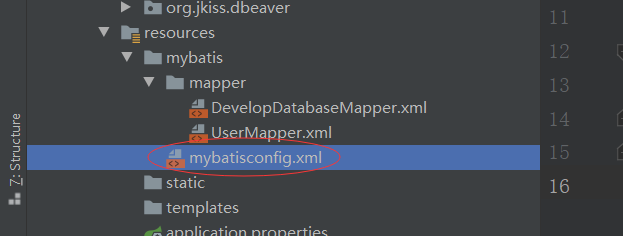Springboot 集成 MybatisPlus
MybatisPlus 使用
MybatisPlus 基于 mybatis开发,主要用于增强mybatis。该文档主要为MybatisPlus 与SpringBoot的集成配置以及一些常用用法,具体的内容请看MybatisPlus与mybatis 官网
一、MybatisPlus 与Springboot集成
1. 引入MybatisPlus 依赖,增加相关配置
-
pom.xml 中增加MybatisPlus依赖
<!-- https://mvnrepository.com/artifact/com.baomidou/mybatis-plus-boot-starter --> <dependency> <groupId>com.baomidou</groupId> <artifactId>mybatis-plus-boot-starter</artifactId> <version>3.5.0</version><!--修改为所需的版本号--> </dependency> -
在
application.properties中增加配置(此处只增加两个最关键的属性配置,其余属性配置可以查看类MybatisPlusProperties)#注:配置mybatis xml文件位置 classpath 指代resources 或者java下 # maven 中的classpath :https://www.jianshu.com/p/62a4053ffd34 # https://segmentfault.com/a/1190000015802324 # * 代表通配符,此处与mybatis中的自动配置不相同。mybatis-plus springboot-starter中将自动配置注解的@ConfigurationProperties前缀由mybatis改为了mybatis-plus # mybatis-plus 配置文件所在位置 mybatis-plus.config-location=classpath:mybatis/mybatisconfig.xml # mybatis-plus mapper 文件所在位置 mybatis-plus.mapper-locations=classpath:mybatis/mapper/*.xmlmybatis-plus springboot 自动配置:springboot启动时将会加载 MybatisPlusAutoConfiguration 类,创建类中配置的bean(相当于以前在xml中配置);如果自己想要增加额外配置,可以增加一个MybatisConfig配置类来进行个性化;自动配置和个性化配置并不冲突(不是增加了个性化配置类之后spring自动配置就不加载了,除非自动配置类的bean方法上标注了@ConditionalOnMissingBean,如果在个性化配置创建了该bean那么自动配置中将不在加载)。
在debug时也可以看到,springboot将会先加载个性化配置类(标注了@Configuration的类),再加载自动配置类。
spring中其他的starter自动配置类也是如此
-
增加自定义配置类
MybatisConfig(可选,用于增加新配置)@Configuration public class MybatisConfig { @Bean //个性化配置 public ConfigurationCustomizer configurationCustomizer() { //return (org.apache.ibatis.session.Configuration configuration) -> configuration.setMapUnderscoreToCamelCase(true); return new ConfigurationCustomizer() { // 对应mybatisconfig.xml 中的 settings扩展点 @Override public void customize(MybatisConfiguration configuration) { //开启驼峰命名 configuration.setMapUnderscoreToCamelCase(true); configuration.setCacheEnabled(true); } }; } } -
在resources目录下增加
mybatisconfig.xml配置文件(可选,用于后续增加配置)<?xml version="1.0" encoding="UTF-8" ?> <!DOCTYPE configuration PUBLIC "-//mybatis.org//DTD Config 3.0//EN" "http://mybatis.org/dtd/mybatis-3-config.dtd"> <!--mybatis 全局配置文件--> <configuration> <settings> <!--开启驼峰命名--> <setting name="mapUnderscoreToCamelCase" value="true"/> </settings> <!--进行别名命名,自定义类型别名 这样就不需要写全限定名--> <typeAliases> <typeAlias type="com.epoint.restore.restore.dao.entity.User" alias="User"/> </typeAliases> </configuration>
2、增加实体类、Mapper接口、Mapper xml文件
此处以user表为例
-
增加实体类User 与数据库中的user表相对应
@Data @TableName("user") //对应数据库中的user表 public class User implements Serializable { @TableId("user_id") //主键ID private Integer userId; @TableField("user_name") //字段注解 与表中字段名相对应 private String userName; @TableField("password") private String password; @TableField("email") private String email; @TableField("register_time") private String registerTime; //直接将时间序列化为字符串 @TableField(exist = false) //表示该字段非数据库字段 private StringBuilder stringBuilder=new StringBuilder(); } -
增加UserMapper接口,继承自 BaseMapper接口,并将泛型标注为User类
@Mapper //标注mapper注解 public interface UserMapper extends BaseMapper<User> { //根据ID查询用户 @Param 映射SQL中的字段,如@Param("username") 和 #{username} 相对应 //你可以传递多个参数给一个映射器方法。在多个参数的情况下,默认它们将会以 param 加上它们在参数列表中的位置来命名, // 比如:#{param1}、#{param2}等。如果你想(在有多个参数时)自定义参数的名称,那么你可以在参数上使用 @Param("paramName") 注解。 //该注解可自定义传入映射器的参数名称,例如此处@Param("user_id"),那么在mapper.xml中的参数名称则为#{user_id} User getUserById(@Param("user_id")Integer id); } -
Springboot启动类上标注
@MapperScan注解,标注Mapper接口位置@MapperScan("com.ysk.restore.restore.dao.mapper") -
在resources 目录中增加对应的UserMapper.xml (该目录位置为appaction.properties的
mybatis-plus.mapper-locations配置的值)文件<?xml version="1.0" encoding="UTF-8" ?> <!DOCTYPE mapper PUBLIC "-//mybatis.org//DTD Mapper 3.0//EN" "http://mybatis.org/dtd/mybatis-3-mapper.dtd"> <!--mapper接口类对应的位置--> <mapper namespace="com.ysk.restore.restore.dao.mapper.UserMapper"> <!--id 为方法名,parameterType为参数类型,该属性可选。 resultType 期望从这条语句中返回结果的类全限定名或别名。 注意,如果返回的是集合,那应该设置为集合包含的类型,而不是集合本身的类型。 resultType 和 resultMap 之间只能同时使用一个。 --> <!--在这些情况下,MyBatis 会在幕后自动创建一个 ResultMap,再根据属性名来映射列到 JavaBean 的属性上。如果列名和属性名不能匹配上,可以在 SELECT 语句中设置列别名(这是一个基本的 SQL 特性)来完成匹配。--> <!--例如: select user_id as "id", user_name as "userName", hashed_password as "hashedPassword" from some_table where id = #{id} --> <select id="getUserById" resultType="User"> select * from user where user_id=#{user_id} </select>


 浙公网安备 33010602011771号
浙公网安备 33010602011771号